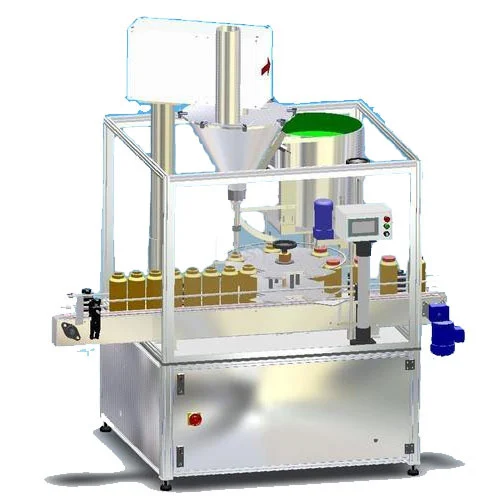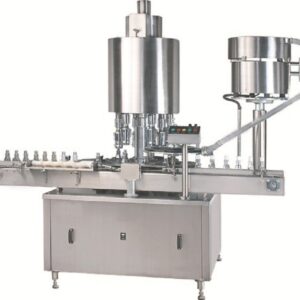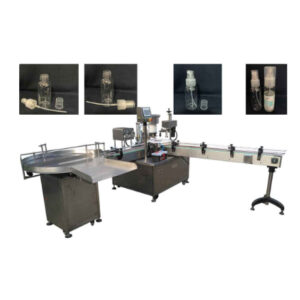Description
-
Parameter Specification Model XYZ-1000 Capacity Up to 100 bottles per minute Bottle Size Range 100ml to 1000ml Cap Size Range 20mm to 50mm diameter Capping Type Rotary Capping Power Requirement 220V, 50Hz Power Consumption 2 kW Air Pressure Requirement 6-8 bar Air Consumption 100 liters per minute Machine Dimensions (LxWxH) 2000mm x 1200mm x 1800mm Weight 800 kg Material Stainless Steel 304 Control System PLC with touch screen HMI Capping Accuracy ±0.5mm Speed Control Variable frequency drive (VFD) Bottle Conveyor Variable speed belt conveyor Cap Feeding Vibratory bowl feeder Safety Features Emergency stop button, safety guards, interlocks Optional Features Date coding, bottle rejection system, cap presence sensor Certification CE and ISO 9001:2015 - In the realm of fluid packaging, the bottling process is often overlooked but is a crucial aspect in ensuring product quality, safety, and integrity. Liquid capping includes securely sealing bottles to avoid leakage, contamination or tampering. This article provides detailed information about liquid bottle capping machines that discusses types, applications functions along with future trends, benefits and many more.
-
Types of liquid bottle capping machine
- Screw Capping: It is one of the most common ways of shutting a liquid bottle. A screw cap is twisted onto the neck of the bottle creating a tight seal. Typically these caps have threads that match those on the neck of the bottle hence allowing for completeness in closure. This type of capping is used widely in industries such as beverages, pharmaceuticals and personal care products.
- Snap Capping: Snap capping entails placing a plastic cap onto a bottleneck which will hold tightly when it snaps into place. Screw caps may not always be practical for bottles containing juices or sauces and similar liquids where proper sealing is required.
- Press-on Capping: Press-on capping employs pressure to push down the cap onto the bottle neck thereby securing it. Bottles having dispensing features like spray or pump caps are frequently fitted with press-on caps. These provide consumer convenience, especially in products like lotions, shampoos and household cleaners.
- Corking: Corking means inserting a cork stopper into the bottleneck to create an air-tight seal around it. The use of cork stoppers for aesthetic appeal as well as flavour/aroma preservation has been a traditional method mostly practised on wine bottles only.
- Tamper-evident Capping: Tamper-evident capping aims at showing evidence such as physical damage upon opening indicating tampering or attempts thereof. This can involve ribbons that tear off when opened induction seals broken or shrink wraps cut open showing where these packages have been tampered with. Tamper-evident caps are extremely important to make sure that products are safe and have consumer confidence, especially in the food and pharmaceutical industries.
-
Applications of liquid bottle capping machine
- liquid bottle capping machine is used in different applications across various industries including;
- Beverages: The beverage industry uses liquid bottle capping machines for water bottles, soft drinks, juices and alcoholic beverages. Screw caps as well as snap caps are commonly used to keep products fresh and avoid leakages.
- Pharmaceuticals: A liquid bottle capping machine is vital in maintaining the integrity of medicine containers, syrups and other liquid formulations. Tamper-evident closures need to be used so that products can be maintained at their highest quality levels with no risk of tampering.
- Personal Care Products: In the personal care sector, liquid bottle capping machines come into play when it comes to packaging such items as shampoos, conditioners, lotions or body washes. Consumers benefit from using press-on caps having dispensing mechanisms since they help control dosage and offer convenience.
- Food Products: Sauces, condiments, cooking oils and dressings among other things are packed using a liquid bottle capping machine. This ensures that the contents are preserved until they reach the consumer’s table or kitchen by adding a tamper-proofing cover on them.
- Chemicals and Cleaning Products: Manufacturers of chemicals, detergents and cleaning agents use this method of sealing their products securely. Press-on caps plus tamper-evident features are incorporated to improve user experience while guaranteeing safety during usage.
-
Functions of liquid bottle capping machine
- The main purpose why liquid bottles require capping include;
- Protection: To avoid compromise of the quality and safety of the product by external contaminants such as dust, dirt, microorganisms and moisture, the liquid contents are capped.
- Preservation: By minimizing exposure to light and air that causes oxidation and degradation of liquid products; efficient bottle capping helps maintain their freshness, flavour and potency.
- Tamper Resistance: Tamper-evident caps tell consumers whether or not the bottle has been opened or tampered with hence they uphold product integrity as well as safety.
- Brand Identity: Consumer perception and purchasing decisions are influenced by what bottle caps look like plus their functionality in terms of brand identity as well as product differentiation.
-
Future Trends in Liquid Bottle Capping Machines
- The future of liquid bottle capping machines will be defined by several trends:
- Automation & Robotics: The adoption rates for automatic capping systems and robots are increasing; this enables faster production speeds, improved precision levels and consistent sealing quality. Moreover, various types of bottles can be handled through robotics since they offer flexibility in shapes and sizes.
- Smart Packaging: To provide real-time tracking, authentication as well and product information to consumers as well as supply chain stakeholders, smart packaging technologies such as RFID tags have been introduced in bottle caps which also bear QR codes.
- Sustainability: Nowadays there is a growing preference for sustainable packaging solutions that utilize environmentally friendly materials for cap making including those with designs that minimize material usage or waste creation. With increased environmental consciousness among customers, it is evident that biodegradable or recyclable caps are becoming popular.
- Innovative Closure Designs: Some are flip-top caps while others are childproof closures but all these innovative closure designs being experimented with by manufacturers have enhanced convenience to users besides offering good protection from tampering. This includes precise dosage control dispensing systems among others
- Quality Assurance Technologies: Quality assurance technology advancements have resulted in more efficient detection of faults during cap inspections i.e. misalignments so far discovered through vision inspection techniques and artificial intelligence.
-
Benefits of liquid bottle capping machine
- Several advantages come with liquid bottle capping machines for manufacturers, retailers and consumers:
- Product Integrity: Properly sealed bottle caps ensure the integrity and safety of liquid products, maintaining their quality and freshness throughout their shelf life.
- Consumer Confidence: Tamper-evident caps provide reassurance to consumers about the authenticity as well as safety of the products they purchase by building trust in the brand.
- Extended Shelf Life: Effective bottle capping helps prolong the shelf life of liquid products by protecting them from environmental factors that could cause spoilage or degradation.
- Convenience: User-friendly capping systems enhance consumer convenience while improving overall product experience therefore leading to customer satisfaction.
- Regulatory Compliance: By ensuring packaging rules as well as regulations relating to bottle capping are adhered to it follows that legal and regulatory requirements will have been met hence avoiding any fines or penalties which may be incurred.
- Brand Differentiation: Having been properly designed, bottle caps usually serve as a brand differentiation point thus contributing towards an increased level of brand recognition among consumers thereby creating brand loyalty too.
-
Sеlling liquid bottle capping machine Linеs Globally
- In such busy United States cities like New York, Los Angeles, and Chicago, it is essential for liquid bottle capping machines to guarantee product quality across various sectors. For example, in cafes in NY, there are beverages while Boston’s laboratories have pharmaceuticals; hence, these areas require safety provided using capping technology.
- Meanwhile back in Canada; the maple syrup makers in Quebec province must use this method to make sure their products remain fresh. Still within the Asia-Pacific region where China, Japan and India together with others exist; Beijing in China, Tokyo in Japan including Mumbai which is a densely populated city in India are some examples that form part of Asian countries that apply advanced capping methods.
- From the wineries of France and Italy to Germany’s breweries, a liquid bottle capping machine is used to preserve the rich taste of drinks. In Saudi Arabia, United Arab Emirates, and Qatar in the Gulf countries such as Riyadh, Dubai and Doha, it is due to this technology that their products are available at all times as per their quality standards. Similarly, a variety of products across Australia from Sydney’s coastal markets to vineyards in Adelaide are preserved using liquid cap bottles so that they may reach consumers while in pristine condition.
-
What is a liquid bottle capping machine?
- liquid bottle capping machine refers to sealing bottles with liquids inside them so that they don’t leak or get contaminated or tampered with.
-
What are common types of liquid bottle capping machines?
- Corking, screwing on caps, snap capping, press-on capping and tamper-evident capping are popular forms.
-
What industries use liquid bottle capping machines?
- Beverages, pharmaceuticals, personal care products including food packaging as well as chemicals require liquid bottle capping machines.
-
What is Tamper evident Capping for?
- Tamper-evident closure or proof is a technique used to ascertain that any attempt at interfering with the packaging has happened showing the safety of items inside.
-
How does a liquid bottle capping machine contribute to product preservation?
- It minimizes exposure to air and light which can cause degradation thus helping retain the good taste fresh scent and potency of a liquid product.
-
What are the benefits of automated systems for liquid bottling machines?
- There is higher precision fast production speeds and consistent seal quality through automated systems which improve efficiency and reduce labour costs.





